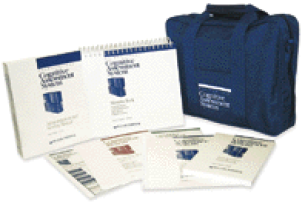Das-Naglieri Cognitive Assessment System (CAS™)
Jack A. Naglieri, PhD and J. P. Das, PhD
|
The CAS is an assessment battery designed to evaluate cognitive processing. It was developed to integrate theoretical and applied areas of psychological knowledge using cognitive processing theory and tests designed to measure those processes–Planning, Attention, Simultaneous, and Successive (PASS)–in individuals ages 5-17 years. • Measures the cognitive processes of Planning and Attention (important for evaluation of attention deficits and brain injuries). • Also measures simultaneous processing (ability to integrate individual stimuli into a single whole/group and understand logical-grammatical relationships), and successive processing (involving working with things in a specific serial order sequence and the formation of sounds and movements in order). • Predicts achievement and evaluates ability-achievement discrepancy. • Facilitates the identification of attention-deficit/hyperactivity disorders, traumatic brain injury, learning disabilities, mental retardation, and giftedness. • Provides flexible administration options: an 8-subtest Basic Battery and a 12-subtest Standard Battery. Organization: To meet examiner need for flexibility, the CAS has two forms, a Standard Battery and a Basic Battery. Each of the two forms is composed of Planning, Attention, Simultaneous, and Successive (PASS) scales. In the Standard Battery, these scales are composed of three subtests each. In the Basic Battery, the scales are composed of two subtests each. Interpretation: Methods to evaluate the results obtained from the CAS are described in The Interpretive Handbook. The Planning, Attention, Simultaneous, and Successive (PASS) scale scores and the Full Scale score are reported as standard scores with a mean of 100 and SD of 15. Subtest scaled scores with a mean of 10 and SD of 3 are also provided. For determining intraindividual differences, tables are provided to evaluate the significance of the differences between the four PASS scale standard scores. Similar tables are provided for evaluating the significance of differences between scaled scores for each subtest within a PASS scale. To assess ability-achievement discrepancies, Simple-Difference and Predicted-Difference tables are provided. These tables are based on the sample that was administered both the CAS and WJ-R Tests of Achievement. Methods for using the PASS scores to identify cognitive strengths and weaknesses, as well as related academic weaknesses, are also given. The unique information obtained from the CAS results is particularly helpful when assessing special populations. The Interpretive Handbook that accompanies the CAS provides additional resources for examiners, including detailed interpretative strategies and implications for intervention based on CAS results. Several research-based programs of instruction directly linked to PASS Theory are also described. Two illustrative case reports, each presenting a written interpretation of CAS results, are also included. COMPONENTS: CAS Administration and Scoring Manual, The Interpretive Handbook, Stimulus Book, 10 CAS Record Forms, 5 CAS Response Books [Ages 5-7], 5 CAS Response Books [Ages 8-17], 10 CAS Figure Memory Response Books, Scoring Templates, and Red Pencil, all in a sturdy canvas carrying case |
Purpose:
Provides cognitive processing measure of ability effective for differential diagnosis & intervention in ages 5-17.11 years
Age Range:
Child
Adolescent
Admin:
Individual
Time:
40 minutes for the Basic Battery (8 subtests); 60 minutes for the Standard Battery (12 subtests)
Qualification:
C



